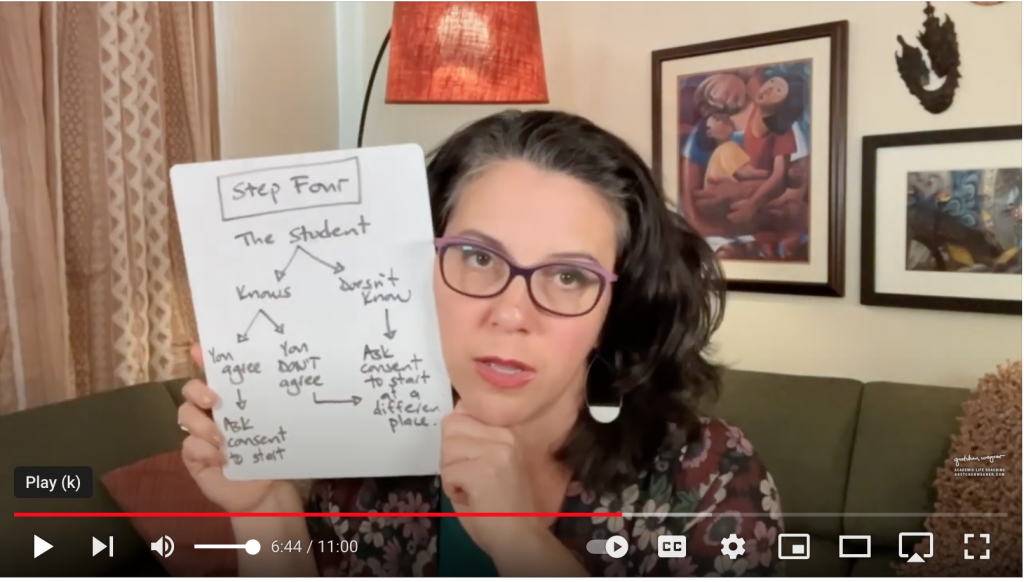Teachers, I know, I know, I know you have very little time to actually work one-on-one with a student to help them figure out what’s going on–why are they not turning in work or why are their grades on tests lower than they would like–but what if there was an exact flowchart that could walk you through how to use very limited time with students to figure out what they need and the strategy that’s going to help them bust through?
Today I’m going to share with you the four steps to quickly help a student problem-solve and find their next action!
First, I want you to know that I came up with the four steps I’m about to share with you because I’m currently coaching in a school context where I have very limited time with students. I have to figure out quickly what’s going on and what are we going to do about it, and make sure the student has takeaways as they leave their time with me. I’ve been watching what I’m doing with students and noticing that there actually is a formula for how you can most quickly and effectively work with students when you have limited time with them.
Now, I will say that my ideal, as somebody who’s been an academic coach for over a decade, is to actually have lots of time with students: to see them on a weekly basis, to be able to coach them as we go through the semester. But, that’s not always the case, especially if you’re a classroom teacher who really has taken on the importance of also being an academic coach to your students. So, here’s how I suggest you maximize your limited time.
Four Steps to Helping Students Out of Overwhelm Quickly
- Let’s imagine you’ve found some private time with a student, either while others are working quietly or 1-on-1 in a classroom or office. You can start by saying, “you know I really want to hear–it seems like you’re super stressed out right now; what exactly is stressful for you?” or simply “what’s stressful? I want to hear,” and then just let the student talk at you for a little bit. Listen for what they seem to be struggling more with: time and task management or studying and learning.
If you’re somebody who’s been trained in my processes, you might also listen for which gear (from the Get In Gear mini lecture I teach) is most out of whack right now or which side of the Study Cycle does the student seem to need more work with?
- After you’ve listened to the student, summarize for them what you heard them say. You might say something like, “it sounds like you’re struggling with blank, blank, and blank–does that sound right?” (NOTE: If you’re a member of my community and you know all the mini lectures, you don’t necessarily at this point need to share which side of the Study Cycle or which gear is most out of whack, but just know that you’re holding that information in the back of your mind.) You might say, “do I have it right?” “did I hear correctly?” or “did I get everything?” The main point is to make sure they feel fully heard before you move on to the next step.
- Next, say something to the effect of, “I’d like to address it all and I have some ideas for you, but if we only have time for one of these topics today, which topic would bring the most relief if we tackled it first?”
This is the question I’m finding myself asking the students I’m working with in the mini laser coaching sessions I’m doing right now. Notice, we started with stress, we’re going for relief, so we’re asking “what would give you the most relief right now?” and it’ll be very interesting to hear what the student has to say.
- All of these steps are important, but this is where you have to do some extra quick decision-making as an educator, so I’ve created a flowchart to help.

First, we need to look at, does the student know what would bring them relief or don’t they?
Then, if they do know, do you agree with their assessment?
Let’s say you had offered, “It sounds like you might need some help seeing where there’s extra time in your day, and you also need help figuring out how to study in ways that are more interesting than just a bunch of flashcards.”
If the student knows and says, “oh, yeah, let’s make my time visible, please–I just can’t even imagine where there’s extra time!” then, you get to check in from the place of your expertise–do you agree with them?
If you agree and you think their analysis is a good one, you can ask consent to start: “Would it be okay if I shared with you ________” and, if they say yes, then you start with that. (For a step-by-step, simple process for asking for a student’s consent, download my free Consent Burger. Getting consent will actually help students be more motivated to take action!)
What if the student says, “I want to start with time management,” but you don’t agree? Maybe you know there’s a test coming up next week and you think if the two of you can problem-solve that right now, that might bring them more relief.
Or, what if the student doesn’t know when you ask them what would bring more relief?
In either case–you disagree or they don’t know–then, we still want to ask consent, but we ask consent to start at a different place than they were thinking. Such as, “oh, I really hear you–time management and making time visible would really bring some relief to you, but I suspect though there’s this thing I can show you about studying flashcards that might actually bring you more relief, given there’s a test next week. Do you mind if we start there first? Then, next time we chat we could talk about making time visible or, maybe at the end today if we still have more time, we can make time visible.”
If they say yes, then you do that.
If they say no, they just don’t really want to do any of this, then I would just end by saying, “Okay, I really want to respect that for right now. I’m here whenever you need me, and I’m going to check in again with you tomorrow to see if things changed. Please think about whether you would like some support with time management or with studying or ________.” That way, you’re letting them know that another time’s coming and they can grow their own comfort level with talking to you about this issue the next day.
This whole sequence can be done pretty quickly, in 10 to 30 minutes, depending on how much time you’re able to glean with the student
I hope you noticed that consent is a very important part of the coach approach. Teachers, we are so used to telling students what they need to do that it can be really hard to wrap our mind around appropriate ways to invite a student to notice what they are and aren’t willing to do. So again, I really recommend you go grab the Consent Burger downloadable, and while you’re at it, sign up for my next free office hours session. You can sign up to get the Zoom link and reminder emails here. That way, you get a deadline! You know you’re gonna’ have to play with some of this stuff and then report in to me at office hours how it went and ask your next question. 😉
I’m totally here for you, and I selfishly hope I get to meet you at the next office hours!

